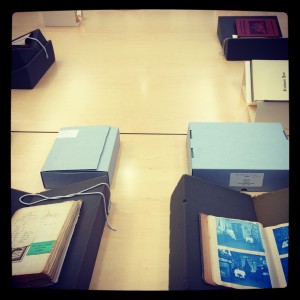Although I’m not teaching a course this semester, I’m still getting to spend time in the classroom, sharing the Greenfield Digital Center’s resources with students and faculty across disciplines. Together we look not only at the growing array of resources Greenfield supports on the web – collegewomen.org, Black at Bryn Mawr, and Greenfield’s own collections exhibits – but also at materials housed in the College Archives: scrapbooks, photograph albums, papers, and more. Some classes are an obvious choice for a Special Collections visit, such as Professor Alicia Walker’s seminar, “Building Bryn Mawr,” where students are studying the early stages of development of Bryn Mawr’s campus, exploring the ways in which the founders of Bryn Mawr understood architecture as a key aspect of the institution’s image and aspirations. But I’ve also worked with faculty to integrate archives materials with class sessions on race and photography, or storytelling and digital narratives. If you ask me, the possibilities are endless! Continue reading
Tag Archives: archives
Silence in the Archives, Part II: New Paths
Featured
For Brenna’s previous reflections on this topic, see Silence in the Archives, Part I: Inviting Inquiry.
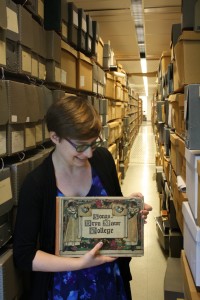
Brenna Levitin ’16 in the College Archives. How do we study lesser-known aspects of Bryn Mawr student life?
Since my unconference session at PhillyDH@Penn, I’ve spent many hours mulling over ways to represent a project which each day becomes more complex. Because of the silence of our archives on the topic of LGBT life at Bryn Mawr, my project now relies heavily on personal accounts, discovered both through oral histories and informational interviews with alumnae/i and members of the faculty and administration.
Oral accounts are notoriously tricky: often narrators mix up names or dates, and personal narratives color everything. It’s the job of the historian (or historian-in-training) to interpret the narrator’s stories and to position them within both the overall narrative and the narrative of their life. It’s important to think critically about what might have shaped a person’s narrative so that we as historians do not naively accept everything we are told: we may hear two accounts which are factually divergent but represent equally valid experiences.
As I slid down the archival silence rabbit hole, it became clear that Omeka, the technology which The Greenfield Digital Center typically uses to create digital exhibits, would not be able to contain a decentralized, testimony-based project such as this one. My supervisor, a more experienced digital humanist than I, suggested an alternate program: Scalar.
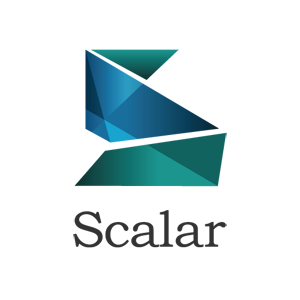 For those unfamiliar, Scalar is an open-source, online tool which allows scholars to build non-linear or multi-linear multimedia “books.” So far, Scalar appears to be a better tool for this project because it can showcase oral histories alongside blocks of text and images. I am especially enchanted by Scalar because it allows items to annotate or comment on other items, a great way to represent many, divergent stories, and because it allows multiple paths. As I build the exhibit, I’ll be able to specify not only an overall, linear path, but also a path which contains major events held by LGBT student groups or one with all of the reported instances of homophobia.
For those unfamiliar, Scalar is an open-source, online tool which allows scholars to build non-linear or multi-linear multimedia “books.” So far, Scalar appears to be a better tool for this project because it can showcase oral histories alongside blocks of text and images. I am especially enchanted by Scalar because it allows items to annotate or comment on other items, a great way to represent many, divergent stories, and because it allows multiple paths. As I build the exhibit, I’ll be able to specify not only an overall, linear path, but also a path which contains major events held by LGBT student groups or one with all of the reported instances of homophobia.
This multi-linear capacity means that not only are we not tied to one narrative, something which history struggles to accommodate at the best of times, but we are also free to portray the richness and diversity of the LGBT experience at Bryn Mawr. Some people loved college life, others didn’t; some were head of the Rainbow Alliance while others stuck to their tight-knit foursome. Every time that I send an email to a community member to request an interview, I include the fact that I’m not just looking for one universal, positive, “gay Bryn Mawr” experience. It’s important to me to amplify the voices of all; for without those voices, our tenuous connection to our history as an LGBT institution would fray irreparably.
Silence in the Archives, Part I: Inviting Inquiry
Featured
When the Digital Center’s TriCoDH summer intern Brenna Levitin ’16 last wrote about her project, she was in the early stages of researching Bryn Mawr’s LGBT history. Recently, Brenna’s focus has shifted to methods for acknowledging silence in the archives, and she is now looking at ways to use her final exhibition project to represent—not fill—that silence.
I’ve begun this blog post four times, each hoping that this iteration will be the one that gels—the one that sums up archival silence in just the right way. I’ve realized, however, that perhaps the problem is the subject matter itself. Archival silence is not an easy topic: each interaction illuminates a single page of history and three blank books. Perhaps that’s why this blog post has been hard to write; after all, writing about what does not exist is difficult and an overwhelmingly foreign task to a fledgling historian.
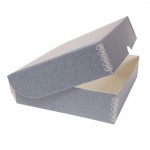 Historians are intimately familiar with silence; one of the first things which my historian major advisor reminded me to think about for this project was silence. Anyone who attempts to write from physical archives knows the weight of the silence contained within; anyone using oral histories acknowledges the silence from those who did not, would not, or could not volunteer.
Historians are intimately familiar with silence; one of the first things which my historian major advisor reminded me to think about for this project was silence. Anyone who attempts to write from physical archives knows the weight of the silence contained within; anyone using oral histories acknowledges the silence from those who did not, would not, or could not volunteer.
My project uses what little the physical archives contains alongside oral histories, cross-referencing the two in an attempt to provide the fullest picture of Bryn Mawr’s LGBT history possible. Even if I am able to confirm the veracity of the information, I still need a way of representing the silence. A truly complete image of history will never be reached for any subject, especially not for any study of minorities. Archives are writ by the victors, not the marginalized sexual minorities.
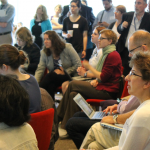
PhillyDH@Penn via Technical.ly Philly
Last month, I explored this topic in an unconference session at PhillyDH@Penn. An animated group discussed visualizing archival silence and its inherent problems. We discussed how to make silence not just noticeable, but enticing; in a physical museum if viewers are invited to uncover something, they are often more likely to look at it. Moreover, the physicality of uncovering actively involves them in the process. They don’t simply gaze passively at a blank space, wonder about it for a moment, and move on; instead they boldly take action, resulting in questioning their assumptions about history as a process and about the preservation of minority culture.
This method of inviting an action or inquiry of an empty or blank space also queers the act of disseminating history. By doing so, not only do we move away from static installations built of text and images; we provoke critical thought about the historical process. Readers are thus encouraged to think as historians, to critically consider the landscape of history as subjective and fluid. As we elucidate the history of queer experiences at Bryn Mawr, my hope is that we also illuminate the historical process. To me, digital humanities is all about making academia accessible. To illustrate archival gaps by revealing the silences and amplifying the voices of queer community members is a worthy goal.
Next week, Brenna’s post will discuss the search for a technology to help document her findings and visualize silence.
